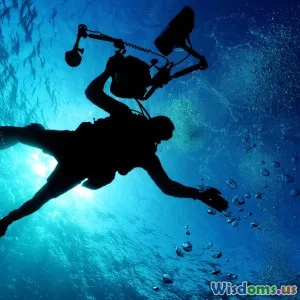
How Technological Innovations Are Changing Scuba Diving Gear in 2024
9 min read Explore groundbreaking scuba diving gear innovations in 2024 transforming underwater experiences for safety, comfort, and eco-friendliness. (0 Reviews)
How Technological Innovations Are Changing Scuba Diving Gear in 2024
Introduction
The exhilarating world beneath the waves has always beckoned adventurers with promises of hidden reefs, spectacular marine life, and serene silence. Scuba diving, though thrilling, relies heavily on gear that ensures safety and comfort while exposed to one of Earth’s most unforgiving environments. As we step into 2024, the landscape of scuba diving equipment is evolving rapidly, driven by groundbreaking technologies that not only enhance divers' experiences but prioritize safety and environmental responsibility.
From AI-powered dive computers providing instant hazard analytics to eco-friendly wetsuits made from innovative biodegradable materials, 2024’s technological breakthroughs are pushing the boundaries of what divers can expect underwater.
In this article, we dive deep into the most impactful advancements shaping scuba diving gear this year, exploring how these innovations improve safety, environmental impact, usability, and overall diving enjoyment.
The Transformation of Dive Computers: From Basic Instruments to AI-Powered Life Assistants
What’s New in Dive Computing?
Traditional dive computers have long served as divers’ wrist-worn guides, calculating no-decompression limits, depth, and time underwater. However, in 2024, these devices benefit from Artificial Intelligence (AI) and machine learning integration.
A prime example is the AquaSense 4X, launched early this year, which uses AI to analyze a diver’s heart rate, breathing patterns, and exertion level alongside oxygen consumption. This real-time physiological monitoring enables the device to predict potential risks like decompression sickness long before symptoms manifest, sending visual or haptic alerts to prompt safer ascent speeds or immediate surfacing.
Real-World Impact
Marine biologist Dr. Laura Hernandez highlights, “AI in dive computers transforms them from passive data recorders to proactive safety tools. It’s like having a personal dive medic on your wrist.”
Enhanced Connectivity
These new computers also sync with mobile apps that log dive profiles, share key environmental data such as water temperature and visibility, and even provide emergency distress signals with GPS location, ensuring rescue teams find divers quickly if needed.
Smarter Buoyancy Control Devices (BCDs): Comfort Meets Control
Adaptive Inflation Technology
In 2024, BCDs have taken a significant leap forward with the introduction of Adaptive Inflation Systems (AIS). Unlike traditional manual or auto-inflators that function primarily on pressure sensors, AIS uses AI to interpret the diver’s body movements, dive profile, and current conditions.
The system adjusts buoyancy more smoothly and intuitively, reducing energy expenditure and preventing sudden buoyancy swings that can increase risk during complex underwater maneuvers.
Lightweight and Ergonomic Designs
Manufacturers are utilizing 3D scanning and bespoke manufacturing techniques to produce BCDs molded precisely to an individual’s body shape. Brands like DeepDive Wearables have reported a 30% reduction in diver fatigue based on user feedback, attributing this to improved fit and weight distribution.
Eco-Friendly Wetsuits and Gear: Sustainability Under the Sea
Innovative Materials Leading the Charge
As coral reefs suffer worldwide, the scuba industry is increasingly responsible for reducing environmental impact. In 2024, wetsuits made from biodegradable polylactic acid (PLA) blends and recycled ocean plastics are mainstream.
One standout is the EcoSeal Wetsuit by OceanTech, crafted using fishing nets retrieved from the Pacific Ocean, renewed into flexible waterproof fabric without harmful chemical processes. Beyond material, these suits feature low-impact dye technologies and biodegradable zippers.
Impact Beyond Materials
Dive fins and masks are also adopting sustainable manufacturing. Companies like BlueMotion Gear employ 3D printing from recycled plastics, significantly cutting waste and enabling personalized, repairable parts—thus extending product life cycles.
Advanced Breathing Systems: More Efficient, Cleaner, and Safer
Rebreather Upgrades
Closed-circuit rebreathers, which recycle exhaled gases for extended dive times and reduced environmental bubbles, have received major innovations.
The ClearBreath S3, introduced this year, incorporates advanced sensors monitoring oxygen and carbon dioxide levels with a self-cleaning system to minimize maintenance efforts. Moreover, it incorporates redundant electronic controls ensuring fail-safe operation—a key advancement to boost diver trust.
Compact Demand Regulators
Demand regulators are shrinking yet gaining in performance, with companies like AquaPure Systems launching compact regulators with anti-fogging nano-coatings and dynamic airflow mechanisms to reduce breathing effort, especially in cold or deep environments.
Immersive Underwater Communication and Navigation
Underwater Smart Masks
New smart mask designs such as DiveVision Pro feature built-in augmented reality (AR) displays projecting crucial dive data directly onto the lens. This enhanced heads-up display allows divers to monitor air supply, depth, elapsed time, and compass directions without distracting hand-held devices.
Voice Communication Breakthroughs
2024 marks a huge leap in underwater communication. Through ultrasonic technology, devices like EchoTalk now permit clear, real-time voice conversations between paired divers up to 30 meters apart, critical for team coordination during scientific research or complex cave diving.
Integrated Navigation Systems
Advanced inertial navigation and GPS technologies work in tandem inside underwater drones or dive scooters, aiding divers in mapping large underwater expanses and finding their way back from intricate labyrinthine coral or cave systems.
Safety and Environmental Monitoring: Guardians of Underwater Realms
Real-Time Environmental Sensors
The latest gear is not just about diver protection but protecting underwater ecosystems as well. Dive units embed sensors detecting water quality, pH, temperature changes, and pollutants, informing divers about conditions that might affect marine life.
Data Sharing and Conservation Efforts
These environmental data streams contribute to global oceanographic databases accessible to conservationists and researchers. For instance, the OceanGuard Project integrates such diver-generated data for early coral bleaching alerts.
Conclusion
The scuba diving gear revolution of 2024 is a testament to how technological innovation can elevate human exploration while safeguarding safety and ecosystem health. With AI-infused dive computers, eco-friendly suits, smarter breathing systems, and integrated communication tools, divers are becoming safer and more connected to marine environments.
These advancements not only enhance individual experiences but contribute to a global movement toward responsible and sustainable diving. For enthusiasts and professionals alike, adapting to and embracing these technologies offers unprecedented opportunities to explore the underwater world deeper, smarter, and greener than ever before.
As technology continues to evolve, the future of scuba diving promises extraordinary innovations that will further push the depths of human adventure and ocean conservation.
Rate the Post
User Reviews
Popular Posts




















